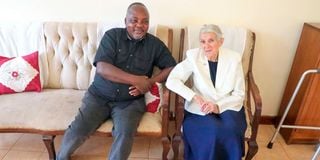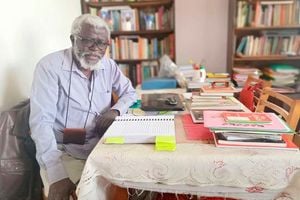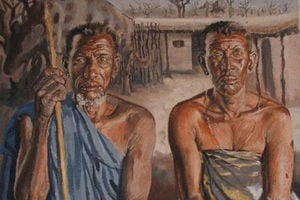
Artist Leonard Kateete and Sister Pauline Boase during the interview at Loreto Convent Msongari in Nairobi on July 1.
Inside the tiny bathroom of the ‘matchbox’ red brick walls built in 1944 on Vilakazi Street Soweto, South Africa, stands the four feet long iconic ‘Tears of Freedom’ portraiture of a grey-haired Nelson Mandela with tears rolling down his wrinkled cheeks against a backdrop of fading footprints.
When the former South African president received the portraiture in July 1990 during his visit to Nairobi, those who were in the room said he was dumbstruck as mixed emotions engulfed his ageing face. He was only six months into his freedom after 27 years in jail.
Mandela keenly studied the detailed drawing for minutes.
He then said to the artist: “Thank you. Thank you.”
The iconic portrait done by Kenyan-based Ugandan artist Leonard Kateete that could have sold for millions of shillings in 1990 now forms part of the Mandela 8115 matchbox house — as natives call it due to its shape—that is now a museum in Soweto.

Portrait of South Africa's first black president, Nelson Mandela, by Kenyan artist Leonard Kateete, mounted in a tiny bathroom in Mandela's former home in Soweto, South Africa.
When Kateete — who was forced into exile to Kenya in 1982 — put final touches to the portraiture and left it to dry, he did not know what the revered anti-apartheid activist looked like as no pictures of him had ever been released since his conviction in the 1960s.
With no AI technology, the artist heavily relied on his imagination to conjure the masterpiece he began working on eight days before Mandela’s release from prison.
Once the paint dried, he named it ‘Tears of Freedom’ for two reasons.
Fighting for liberation
“First it was to depict Mandela’s freedom after all his work fighting for liberation, and secondly, it was about my freedom having reflected on Idi Amin whose regime resulted in my departure from Uganda to Kenya in 1982,” Kateete tells this writer in Nairobi.
The Nelson Mandela National Museum, commonly referred to as Mandela House’s attendants told Sunday Nation that Mandela held the portrait in high regard as one of the most priceless gifts he ever received.
To prevent the painting’s details from wearing off from frequent touching by hordes of tourists who visit the museum each day, the portrait has been reinforced behind a clear glass.
But where does the story of Kateete (80 percent of his distinguished collections are proudly displayed at the National Art Gallery of Kenya, and at the Holy Family Basilica) and his worldwide famous Mandela painting begin?
At exactly 4:14 pm (South African time) on February 11, 1990, Nelson Madiba Mandela, the country’s once most wanted man, walked out of Victor Verster Prison hand in hand with his then-wife Winnie Madikizela after spending 27 years behind bars.
A mammoth crowd had waited for hours in the sweltering heat in anticipation of catching sight of the revered apartheid activist who had disappeared from their view in 1964 after delivering a four-hour speech at the conclusion of his apartheid government sabotage trial where he was sentenced to life in prison.
The apartheid government did not release photos of him during his 27 years in incarceration in the hope of curbing his growing fame after his conviction. Few people knew what he looked like at the time of his release. He was 71 when he left prison.
A week before his release the then South African president FW de Klerk had announced he would set Mandela free without setting the exact date.
The news sent South Africa and large parts of the African continent into a frenzy of jubilation.
By the time of his conviction in 1964, Mandela, a former boxer, was a rugged man in his 40s with full cheeks and a beard. He always dressed in suits at his court appearances. Those were the last images of him seen in public.
Mandela’s fame grew over the years even while in prison. By 1990 he had taken an almost mythic status.
Mythic status
The activism by African National Congress (ANC), a political movement under which Mandela causatively led large-scale demonstrations against oppressive apartheid laws administered to blacks, had continued to agitate and push for his release.
The ANC’s activism was lively beyond South Africa’s borders, with its representatives stationed in friendly African nations including Kenya.
‘Tears of Freedom’
When the news of Mandela’s intended release reached Kenya, at the Loreto Convent Msongari, an impromptu staff meeting was convened by its then principal, retired Sister Pauline Boase.
Sr Boase spoke to Sunday Nation a few days ago after she had just celebrated her 89th birthday at the school.
She said that just before Mandela’s release, she suggested to her staff that they set up a competition for the students to draw portraits of a Xhosa chief out of respect and affection for Madiba.
“Everybody at the school was pro -Mandela. Everyone was very enthusiastic and excited when we learnt of his pending release. We learnt all of the African hymns about Africa and Mandela. We were very teed-up for the Mandela release, we wanted to have a celebration to celebrate his liberation. I said to the staff and students that I needed a picture of Mandela. We can’t just celebrate in a vacuum,” Sr Boase said with a frail voice but a sharp memory.

Leonard Kateete an artist during an interview at Loreto Convent Msongari, Nairobi on July 1, 2024.
The task of overseeing the painting competition fell on Kateete, who stepped in as the Msongari Arts teacher, in place of his wife who was away on maternity leave. The wife is now deceased.
The main hurdle was where to find Mandela’s current photo, as there was none. It was at this point that Kateete, a Fine Arts graduate from the Margaret Trowel School, Makerere University, had to rely on his creative skills.
“There was a small older photo of Mandela, about the size of a passport photo, on the Times Magazine. So Kateete and myself put it on a photo enlarger machine we had at the time, and drew the outlines. That is all you could get from it, but Kateete was smart enough to know how he could go about it,” on how he went about it,” Sr Boase said with a chuckle.
At 8pm on February 4, 1990 Kateete began making sketches of Mandela, who was fondly known as Madiba, staying up until 3am.
“There was a groundsman who worked at the school who had some resemblance with Mandela. I asked him to pose for me so that I could give the portrait a more natural look. His skin texture matched that of Mandela,” Kateete, who is now 75, narrated.
Meeting Mandela
Kateete had never expected to ever meet Mandela. Not a single thought had crossed his mind that the finesse and flair he put into the body of work would be his ticket to meeting the world's most famous man at that time.
Because of the hype and buzz surrounding Mandela’s pending release, a lot of paintings of Mandela had been done by other artists too. The paintings were taken to the offices of the ANC representatives in Nairobi.
But it was Kateete’s ‘Tears of Freedom’ that was picked as it captured the image of the freedom fighter’s face and his mood, with Robben Island in the background.
“When I saw the portrait I was speechless. I suggested to Mr Kateete that he should sell it to the ANC, as it was impeccable. Someone else also urged him to sell it for Sh1 million. It was a lot of money in the 1990s, but Kateete refused,” Sr Boase added.
Kateete interjects: “I don’t regret not selling the painting. How much money could I have asked for? No amount of money is worth that painting. My conviction was that only Mandela deserved it,” the artist said.
To spice up the celebrations, Sr Boase used her connections and assistance from the ANC Nairobi representative to invite the ANC Secretary-General, the late Edward Makasi.
“When the late Makasi saw the portrait he too was speechless. He said Mandela was coming to Kenya, and invited both of us.” Sr Boase recalled.
On July 11, 1990 Mandela arrived in Nairobi with his wife Winnie on his way to attend the Organization of African Unity Summit in Addis Ababa. As part of his itinerary, Mandela wanted to meet the ‘Tears of Freedom artist’, visit Field Marshal Dedan Kimathi’s grave, meet Kimathi’s widow, Mukami Kimathi; and the former Mau Mau commander General China (real name Waruhiu Itote). Madiba had drawn a lot of inspiration from the Mau Mau movement.
“Word had gone round about my painting. There were senior people in government who didn’t want me to present the painting personally to Mandela. They said that I should give them the painting and they will present it,” Kateete said.
After failing to meet the painter, before Mandela’s departure, he asked to meet journalists to thank them for their support as well as the artist.
“Sr Pauline, my late wife and I were hurriedly called to the State House by Mr Makasi. The meeting that lasted 40 minutes was profound. That is when I presented the portrait. When he unwrapped the painting, he was mesmerised. He studied it for a few minutes before thanking me,” Kateete said.
Sr Boase vividly remembers the events of that day too. She said it was the best ever experience of her life.
“I had never thought Mandela was that tall. Winnie was a little controversial. She asked if it doesn’t get boring to be a nun. She said that I should get married to Kateete because of the good chemistry between us. I pointed to Kateete’s wife and said he was married. She said that he should marry me as his second wife,” she said.
Exile
As a fresh graduate from Makerere, Kateete painted dictator Idi Amin’s portrait and he was impressed. He was introduced to Amin and he was commissioned to do artwork for a number of organisations which earned a lot of money. When Amin was toppled in 1978-79, everyone close to him was hunted down. He fled to Kenya in 1982. He has been an art teacher in Kenya since then.
Kateete’s other iconic portrait is that of former US President Richard Nixon and his family which is displayed in the Nixon Museum, USA







